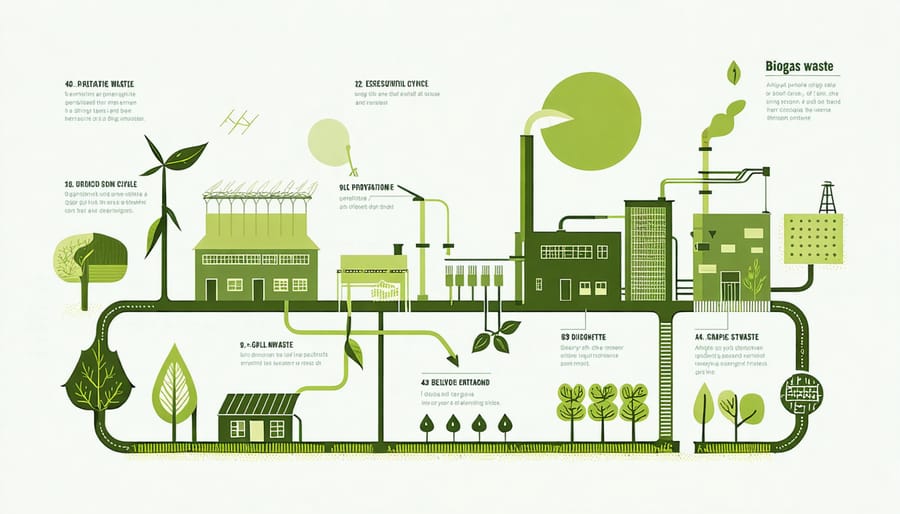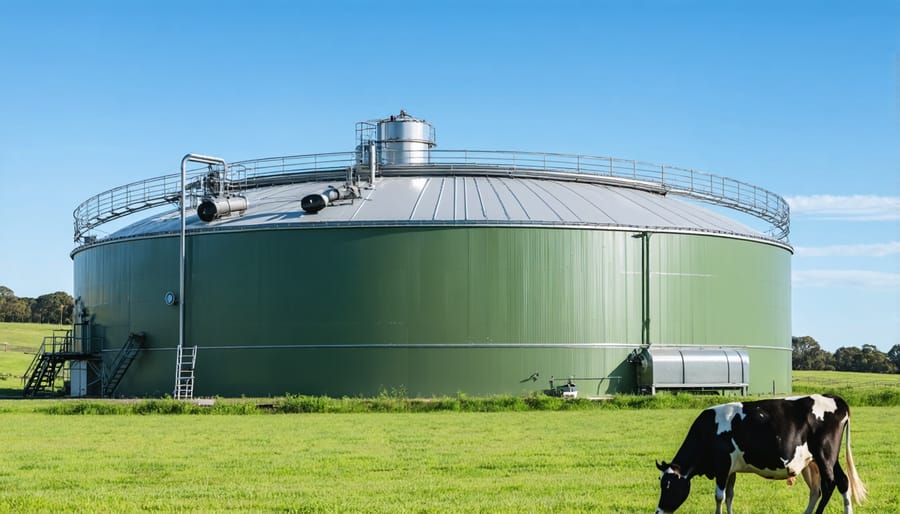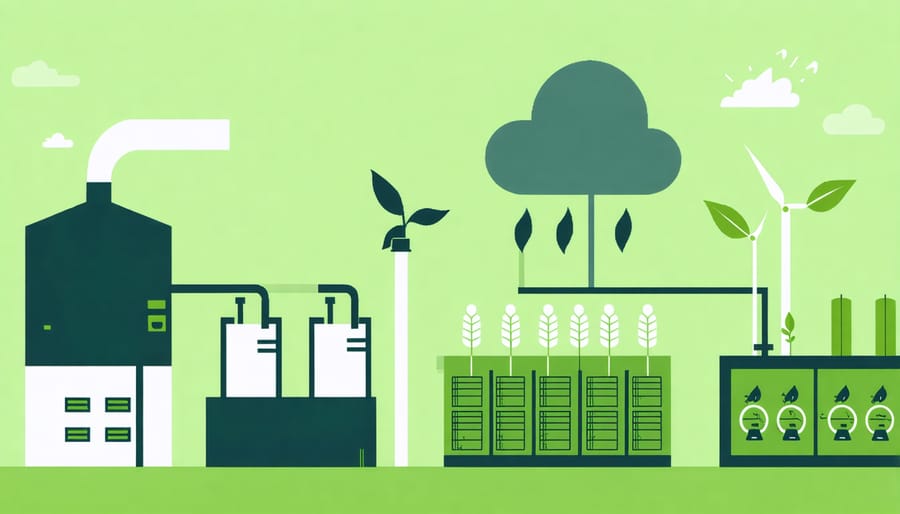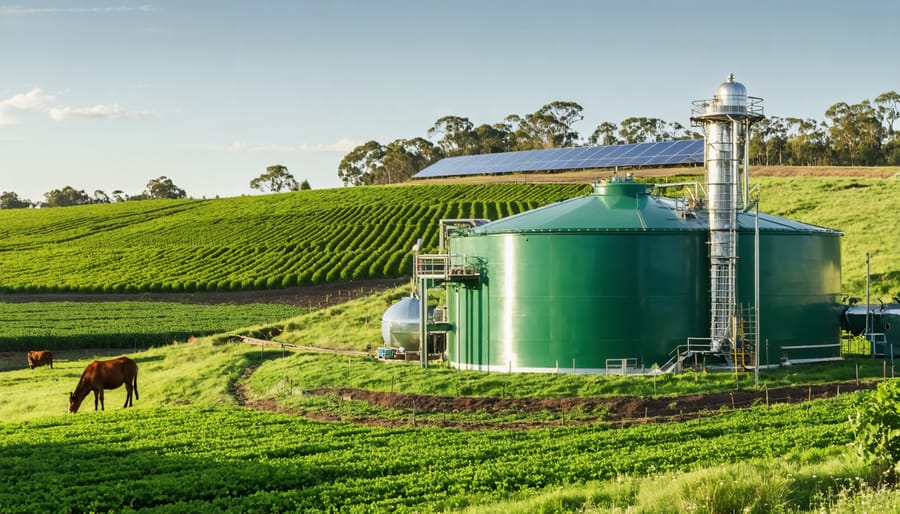In the face of mounting energy challenges and climate concerns, biogas emerges as a transformative renewable energy solution that’s revolutionizing Australia’s approach to sustainable power generation. By converting organic waste into clean, versatile energy, biogas technology offers a powerful twin benefit: reducing landfill waste while producing reliable, carbon-neutral fuel for homes, businesses, and industries.
From small-scale farm digesters generating enough power for local communities to massive municipal waste processing facilities powering entire suburbs, biogas installations across Australia demonstrate the remarkable versatility of this renewable resource. These systems are already preventing millions of tonnes of methane emissions from entering our atmosphere while creating valuable byproducts like nutrient-rich fertilizer.
The timing couldn’t be better. As Australia accelerates its transition to renewable energy, biogas provides the unique advantage of consistent, 24/7 power generation – a critical complement to intermittent solar and wind resources. With abundant organic waste from our agricultural, food processing, and urban sectors, we’re uniquely positioned to harness this sustainable energy source at scale.
This natural, circular approach to energy production represents more than just an environmental solution – it’s a compelling business opportunity that’s reshaping our energy landscape and driving us toward a more sustainable future.
The Power of Biogas: From Farm Waste to Green Energy
What Makes Biogas a Game-Changer
Biogas stands out as a remarkable renewable energy solution because it transforms what we typically consider waste into valuable, clean energy. Through a natural process called anaerobic digestion, organic materials like food scraps, agricultural waste, and sewage break down in oxygen-free environments, producing a methane-rich gas that can be used just like natural gas.
What makes this process truly game-changing is its circular nature. While other renewable energy sources like solar and wind harness natural elements, biogas actually helps solve multiple challenges simultaneously. It reduces waste going to landfills, cuts greenhouse gas emissions, and creates a reliable energy source that can be stored and used on demand.
In the Australian context, biogas presents an especially promising opportunity. Our agricultural sector produces significant organic waste that could be converted into energy, while our remote communities could benefit from local, sustainable power generation. From powering farms with animal waste to running city buses on processed food scraps, biogas offers practical solutions that make environmental and economic sense.
The beauty of biogas lies in its adaptability – it can be scaled from small farm operations to large industrial facilities, making it accessible to various users while contributing to Australia’s renewable energy targets.

Key Components of a Biogas System
A well-designed biogas system comprises several interconnected components working together to transform organic waste into renewable energy. At its heart is the anaerobic digester, a sealed tank where organic materials break down in an oxygen-free environment. This primary component is supported by pre-treatment facilities that prepare the feedstock through sorting, grinding, and mixing processes.
The system includes a gas collection and purification unit that captures and cleans the biogas, removing impurities like hydrogen sulfide and moisture. Modern facilities incorporate advanced energy storage solutions to maintain a consistent supply, even when production fluctuates.
Essential monitoring equipment tracks temperature, pH levels, and gas production, ensuring optimal performance. The setup also features a combined heat and power (CHP) unit or biogas upgrading system to convert the gas into electricity or biomethane. Safety mechanisms, including pressure relief valves and gas detection systems, are integrated throughout.
To complete the cycle, the system includes digestate handling equipment to manage and process the nutrient-rich byproduct, which serves as an excellent organic fertiliser for Australian farms.
Australian Success Stories: Biogas in Action
Dairy Farms Leading the Change
Across Australia, dairy farms are emerging as pioneers in biogas energy production, showcasing how agricultural waste can become a valuable renewable resource. The Gippsland-based Mason Family Farms stands as a shining example, having transformed their 800-cow operation into a self-sufficient energy hub. Their biogas system not only processes 30 tonnes of manure daily but also generates enough electricity to power their entire farm operations and send surplus energy back to the grid.
In South Australia, the Robertson Dairy collective has taken innovation a step further. Their state-of-the-art biogas facility combines dairy waste with local food processing residuals, creating a more efficient digestion process. The project has slashed their energy costs by 75% while reducing greenhouse gas emissions by an estimated 3,500 tonnes annually.
The Sunshine Coast’s Green Pastures Farm demonstrates how smaller operations can benefit from biogas technology. Their 200-cow farm utilizes a compact digester system that provides enough energy to run their milking shed and processing facility. The farm has become a learning centre, hosting regular tours for other farmers interested in adopting similar systems.
These success stories highlight how dairy farms are leading Australia’s transition to renewable energy. Beyond generating clean power, these initiatives have created additional revenue streams through carbon credits and reduced operational costs, proving that environmental stewardship and business success can go hand in hand.

Municipal Waste to Community Power
Australian communities are increasingly turning to municipal waste-to-energy projects as innovative solutions for both waste management and energy production. A standout example is the Yarra Valley Water’s ReWaste facility in Melbourne, which processes local food waste into biogas, powering their water treatment plant and feeding excess energy back into the grid. This facility alone diverts 33,000 tonnes of food waste from landfills annually while contributing to local renewable energy infrastructure.
In Shellharbour, NSW, the community biogas initiative transforms organic waste from local restaurants and food processors into clean energy, powering over 1,200 homes. This project not only reduces waste management costs but also creates local jobs and promotes circular economy principles.
The Byron Bay Bioenergy Facility showcases how tourist destinations can convert hospitality industry waste into valuable energy resources. The facility processes organic waste from hotels and restaurants, generating enough power to meet the needs of hundreds of local households while significantly reducing the region’s carbon footprint.
These success stories demonstrate how municipal waste-to-energy projects can create multiple benefits: reducing landfill waste, generating renewable energy, creating employment opportunities, and fostering community engagement in sustainability initiatives. As more councils adopt these solutions, Australia’s biogas sector continues to grow, proving that local waste can indeed become a valuable community resource.

Environmental and Economic Benefits
Slashing Carbon Emissions
Biogas production stands as a powerful weapon in Australia’s fight against climate change, offering substantial potential for reducing greenhouse gas emissions. When organic waste decomposes in landfills, it releases methane – a greenhouse gas 25 times more potent than carbon dioxide. By capturing this methane through biogas systems, we’re not just preventing harmful emissions; we’re turning a problem into a solution.
Recent studies show that implementing biogas systems across Australia’s agricultural sector could reduce carbon emissions by up to 9 million tonnes annually – equivalent to taking nearly 2 million cars off the road. Leading the charge, dairy farms in Victoria have demonstrated how integrating biogas digesters can slash their carbon footprint by up to 60% while generating renewable energy for operations.
The environmental benefits extend beyond direct emission reductions. Biogas systems work harmoniously with other carbon capture technologies, creating a comprehensive approach to emissions management. By processing organic waste that would otherwise decompose in landfills, these systems prevent methane release while producing renewable energy and nutrient-rich fertiliser.
The ripple effect is significant – from reducing dependence on fossil fuels to minimising waste transportation emissions. For every tonne of organic waste processed through biogas systems instead of landfilling, we prevent approximately 1.9 tonnes of CO2 equivalent from entering the atmosphere. It’s a win-win solution that transforms waste management while actively combating climate change.
Creating Green Jobs and Revenue
The biogas industry is emerging as a significant job creator in Australia’s renewable energy sector, offering diverse employment opportunities across the entire value chain. From plant construction and maintenance to waste collection and processing, biogas facilities create sustainable jobs that support local communities and boost regional economies.
Recent industry reports indicate that for every megawatt of biogas capacity installed, approximately 11 direct jobs are created, with additional indirect employment opportunities in supporting industries. These positions range from skilled technicians and engineers to operations managers and environmental compliance officers.
Success stories like the Earthpower facility in Sydney demonstrate the economic potential of biogas projects. The facility not only processes organic waste from the metropolitan area but also employs over 30 full-time staff and contributes significantly to the local economy through procurement and services.
Beyond job creation, biogas projects generate multiple revenue streams. Facilities can earn income from waste management fees, sale of renewable energy, and the production of high-quality organic fertilizers. Many agricultural operations have found that installing biogas digesters provides additional income while solving waste management challenges.
For rural communities, biogas projects offer particularly promising opportunities. Farmers can diversify their income by converting agricultural waste into energy, while local councils can reduce waste management costs and create new revenue sources through community-scale biogas initiatives. This creates a win-win situation where environmental benefits align with economic growth and job creation.
Getting Started with Biogas
Assessment and Planning
Before implementing a biogas system on your property, a thorough assessment is essential to determine its feasibility and potential benefits. Start by evaluating your available organic waste streams, including agricultural residues, food waste, or animal manure. Document the quantity and consistency of these materials throughout the year to ensure a stable supply.
Next, assess your property’s spatial requirements. A typical biogas system needs space for feedstock storage, the digester unit, and gas storage facilities. Consider factors like proximity to waste sources, existing infrastructure, and local council regulations regarding waste management facilities.
Calculate your energy needs and potential biogas yield. This involves analyzing your current energy consumption patterns and estimating how much of it could be offset by biogas production. Modern smart energy management systems can help optimize this process and maximize efficiency.
Financial planning is crucial. Consider initial investment costs, including equipment, installation, and necessary permits. Factor in ongoing operational expenses like maintenance, labor, and feedstock transportation. Research available government incentives and renewable energy certificates that could improve your project’s viability.
Environmental impact assessment is another vital step. Evaluate how the system will affect local water resources, air quality, and soil conditions. Consider potential odour management requirements and develop strategies to minimize environmental impacts.
Finally, create a detailed implementation timeline. This should include key milestones like permit applications, construction phases, and system commissioning. Consider seasonal factors that might affect construction or system operation, particularly in Australia’s diverse climate zones.
Available Support and Resources
Australia offers robust support for biogas projects through various government initiatives and industry programs. The Renewable Energy Target (RET) scheme provides financial incentives for biogas installations, while the Emissions Reduction Fund (ERF) offers carbon credit opportunities for qualifying projects.
The Clean Energy Finance Corporation (CEFC) provides competitive financing options for commercial-scale biogas facilities, with loans starting from $10 million for eligible projects. Small-scale operators can access grants through state-level renewable energy programs, such as the Victorian Renewable Energy Target (VRET) and the Queensland Renewable Energy Fund.
Technical assistance is readily available through organizations like Bioenergy Australia and the Australian Renewable Energy Agency (ARENA). These bodies offer expertise, feasibility study support, and connection to industry specialists. The Biogas Network Australia facilitates knowledge sharing and provides mentorship opportunities for new projects.
Regulatory frameworks for biogas projects are overseen by state environmental protection agencies, which provide clear guidelines for safety, environmental compliance, and operational standards. The National Australian Built Environment Rating System (NABERS) recognises biogas initiatives, offering certification benefits for commercial buildings incorporating biogas systems.
For farmers and agricultural businesses, the Rural Research and Development Corporations offer specialized funding for on-farm biogas projects. Local councils often provide additional support through streamlined approval processes and connection to waste management infrastructure.
To get started, contact your state’s renewable energy body or visit the Department of Industry, Science, Energy and Resources website for comprehensive information about available support mechanisms. Industry associations also maintain updated databases of funding opportunities and technical resources for biogas projects.
As we’ve explored throughout this article, biogas represents a powerful solution for Australia’s renewable energy future. By converting organic waste into clean, sustainable energy, we’re not just addressing our energy needs – we’re tackling waste management challenges while reducing greenhouse gas emissions. The success stories from farms in Victoria to industrial facilities in Queensland demonstrate that biogas technology is not just viable but thriving in our unique Australian context.
The potential for biogas in Australia is enormous. With our abundant agricultural resources, extensive food processing industry, and growing urban centres, we have all the ingredients needed to create a robust biogas sector. The technology is proven, the benefits are clear, and the time for action is now.
We encourage farmers, business owners, local councils, and industry leaders to explore how biogas can benefit their operations. Start by assessing your organic waste streams, connecting with local biogas experts, and investigating available government incentives. For policymakers, supporting biogas initiatives through targeted policies and funding programs can accelerate our transition to a more sustainable energy future.
Together, we can transform our organic waste into a valuable energy resource, create new jobs in the renewable sector, and help Australia meet its climate commitments. The future of renewable energy is here, and biogas is ready to play its part in powering our nation forward sustainably.

